Quitting smoking is a transformative journey that leads to numerous health benefits and a better quality of life. This article presents a detailed timeline of the first 14 days after quitting smoking, followed by a month-by-month breakdown of up to 12 months. We will delve into the daily experiences, emotional changes, bodily cleansing processes, suggestions for success, and the vital roles that relatives and healthcare professionals play in supporting those who choose to stop smoking.
So what happens when you quit smoking?
Day 1

Body Changes
Carbon monoxide levels in the blood decrease and red blood cells improve their oxygen transport function. This leads to increased oxygen content in the body tissues.
Emotional and Mental State
Emotions experienced during this process include joy, pride, and confidence. You’ll feel proud of yourself for deciding to quit, joyful about the desire to quit, and confident in your final decision.
Cravings for cigarettes either disappear or become very weak. These cravings can be easily interrupted by positive affirmations like “I quit smoking!” and are mainly associated with habitual rituals.
You may experience mild physiological sensations such as dizziness, loss of appetite, weakness, and moderate anxiety. Additionally, difficulty falling asleep and poor sleep might occur.
Doctor’s Advice
If you feel nervous or anxious during this period, do not rush to treat it medically, as these feelings are likely temporary and not severe. They are often a result of emotional changes.
Continue taking any prescribed medications for other conditions, whether they are chronic or acute. Quitting smoking might be challenging during a severe exacerbation of another illness, but such situations can also motivate you to quit.
Homemade Remedies
If you find the process of quitting smoking stressful, try making yourself blackberry tea or consuming blackberry jam. For the tea, brew 2 tbsp. of crushed blackberry leaves in a thermos with two cups of boiling water, soak for 2 hours, add honey to taste, and drink half a cup of warm infusion three times a day, 20 minutes before meals. Eating two or three tablespoons of jam per day can also be beneficial.
Importance of Physical Activity
Consider starting to engage in sports or physical activities during the first few days of quitting. The initial days are when you might feel the most motivated to begin exercising.
However, be mindful of your health condition and avoid activities that may cause nausea or dizziness in the early stages of quitting.
Advice for Those Quitting Smoking
Acknowledge that the journey to quit smoking may be difficult and lengthy. Be present in the process and avoid being too hard on yourself.
Although support is appreciated, avoid crossing the line with sympathy or making jokes about past unsuccessful attempts to quit smoking, as it may not be helpful.
Day 2

Body Changes
The lungs produce less mucus, and the ciliated epithelium in the lungs functions better. The initial signs of nicotine withdrawal become noticeable. The cells in the intestinal lining start to regenerate.
Emotional and Mental State
The euphoria experienced on the first day continues, but irritability and nervousness may start to emerge. You can use self-hypnosis techniques to reduce cravings for cigarettes. Drowsiness might occur, followed by a surge of energy.
Physiological State
Decreased appetite or cravings for strongly flavored foods, shortness of breath, and increased coughing. Moderate abdominal pain and frequent urination can be experienced. Falling asleep becomes difficult, and sleep may be shallow. There might also be sensations of skin itching and tightness.
Doctor’s Advice
This day feels similar to the previous one, with no overwhelming urge to smoke yet, but irritability may be slightly stronger. Irritability can be easily suppressed, and the desire to smoke can be controlled with willpower. Remember the reasons that motivated you to quit smoking. Adequate sleep and creating a stable psycho-emotional environment can help alleviate the unpleasant sensations of this day.
Homemade Remedies
It can be beneficial to start taking a solution of apple cider vinegar. Mix 3 teaspoons of apple cider vinegar with 150 grams of honey. Take 2 teaspoons at bedtime to help with severe irritability, fatigue, and weakness. You can repeat the intake of this herbal sedative and sleep aid in the middle of the night.
If you experience a cough, traditional medicine suggests mixing half a glass of fresh cabbage juice with honey. Take 1 tablespoon three times a day, 30 minutes before meals.
Importance of Physical Activity
Unpleasant sensations behind the sternum may occur, as the recovery processes often make it feel worse before getting better. Breathing can be difficult, especially when lying down or exerting effort. Periodic abdominal pain might be a sign of possible future issues with bowel movements. It’s advisable to avoid exercises that increase intra-abdominal pressure in your morning exercise routine. These include active jumping, forward bending (sideways bending is permissible), body flexion in the prone position, and twisting motions with a hoop. Experienced athletes and fitness enthusiasts can assess the benefits or potential risks of specific exercises, but beginners and occasional exercisers should exercise caution.
Tips for Those Quitting Smoking
Practice patience; this is just the beginning. The hope and faith that filled you yesterday and today are likely being shared with others, and you may be seeking confirmation of your progress. Be patient, share your journey, and listen to others. Additionally, consider planning your future behavior and how you can support yourself in the near future.
Day 3

Body Changes
The process of repairing the ciliated epithelium and bronchial mucosa starts. There is an increase in alkaline fractions in the pancreas, a decrease in trypsin secretion, and a reduction in stomach mucus production. Blood flow to the heart and brain increases, and blood vessel tone stabilizes. The physical attraction to nicotine decreases at the cellular level.
Emotional and Mental State
Nervousness intensifies. Signs of psychological dependence become more pronounced, and individuals may struggle with distracting thoughts and restlessness, indicating a “withdrawal syndrome.” Falling asleep becomes difficult, and sleep is frequently disrupted, leading to anxious feelings.
Physiological State
Appetite significantly increases, with a craving for sweets. Heartburn and belching may occur, and dizziness can be especially noticeable when bending over. Individuals might experience a feeling of pressure on the heart and tinnitus. Peeling and small dry pimples may appear on the skin.
Doctor’s Advice
- Avoid relying on over-the-counter pills for nerves, as their effectiveness may be unproven or placebo. Be cautious about developing a new pharmacological addiction when trying to quit smoking. Instead, consider taking a shower with a gel for dry skin and applying moisturizing cream, such as “Children’s” cream, after water procedures.
- Consult with a doctor who might prescribe aspirin in a dosage of 1/4 tablet of regular acetylsalicylic acid once a day at night. Aspirin can help relieve dizziness and tinnitus by thinning the blood. However, it’s important not to start taking aspirin without medical advice, as it has contraindications.
Homemade Remedies
- For dizziness, prepare an infusion using 100 grams each of immortelle, St. John’s wort, and chamomile (dry). Mix 1 tablespoon of the herbal blend with 0.5 liters of boiling water, steep under a lid for 20 minutes, and strain. Drink the warm infusion before bedtime and in the morning, adding 1 teaspoon of honey to a glass.
- For heartburn, dissolve honey in a glass of warm boiled water (30-60 grams of honey per dose, totaling 40-80 grams daily). Take it 1.5-2 hours before breakfast, lunch, and 3 hours after dinner to alleviate nausea, heartburn, and stomach pain.
- Alternatively, you can take 50 ml of apple cider vinegar before meals, once a day, for 2-3 weeks to reduce or eliminate heartburn. Dilute the vinegar in double the amount of water. This method can replace the previous day’s advice of mixing vinegar with honey, following the same dosing schedule.
Importance of Physical Activity
Continue engaging in sports, fitness, or regular home workouts. The movement supports the vessels, which is particularly important during this time. Pay attention to your body’s sensations to avoid unwanted effects during exercise.
Tips for Those Quitting Smoking
If you notice that someone quitting smoking is consuming excessive sweets, consider keeping sweets and cookies out of their reach. The coming days may increase the craving for sweets, and the pancreas can be sensitive during this period. Instead, opt for dried fruits as a healthier alternative.
Day 4

What happens in the body
Blood flow to the brain improves. Stomach and pancreatic processes continue. Intestinal peristalsis may decrease. Lung repair and normal bronchial secretions occur. The bronchial tone is reduced.
Emotional and Mental State
Aggressiveness decreases, and mood fluctuates. Confusion in behavior and disrupted sleep can occur.
Physiological State
Possible increase in blood pressure and ringing in the ears. Dizziness may be weak or absent. Constipation, normalized urination, decreased appetite, coughing, and facial swelling may occur.
Doctor’s Recommendations
Address sleep issues with herbal remedies like motherwort or aromatic oils. Consider using “Extraplast” patches for insomnia.
Homemade Remedies
- Use a herbal mixture for headaches, insomnia, and low mood. Cranberries can help with cough and throat discomfort.
Importance of Physical Activity:
- Include squats in exercise routines to stimulate bowel movements.
Tips for Close Ones:
- Encourage a diet that stimulates intestinal activity. Provide support to prevent relapse, such as avoiding alcohol or smoking environments.
Day 5

What happens in the body
Microtraumas on the surface of the tongue heal. Changes in blood vessel tone, which occurred due to the absence of nicotine and its metabolites, become familiar to the body. The recovery processes begin in the distant segments of the bronchopulmonary system. The intestinal tone remains disrupted.
Emotional and Mental State
It is a challenging day as the euphoria of the first days fades, and overall well-being worsens with the emergence of “betraying” thoughts. The risk of relapse is significant during these days and the following ones.
Physiological Sensations
Food regains its true taste, especially products with pronounced flavors like citrus fruits, cheese, and smoked meat. A loose, mucus-like lump is felt in the throat or chest, making breathing difficult. Coughing may produce thick, dark-colored mucus.
Doctor’s Recommendations
Many find relief in taking enterosorbents, which help eliminate toxins and normalize intestinal motility. Consult with a doctor to find the appropriate medication for you.
Homemade Remedies
For stomatitis, a herbal mixture with eucalyptus leaves, flax seeds, chamomile, and lime flowers can be helpful. Gargle with the prepared infusion four to five times a day until complete healing. Alternatively, mix 10% propolis tincture with vegetable oil and apply it to the mouth ulcers and tongue.
Importance of Physical Activity
Regular exercise is an effective preventive measure against constipation. Aim for a minimum of 4 kilometers of walking per day to keep the intestines active.
Tips for Close Ones
Understand that the irritated, tearful, or moody person you see now is the same person who was happily chatting while holding a cigarette not long ago. The negativity expressed towards loved ones is not from them; it’s the painful attachment that finds it challenging to part with the habit. Just like it’s hard to let go of a beloved item that was once trendy and stylish but is now only fit for a museum or worn out, your loved one is now parting with a piece of their identity. Patience for everyone…
Day 6
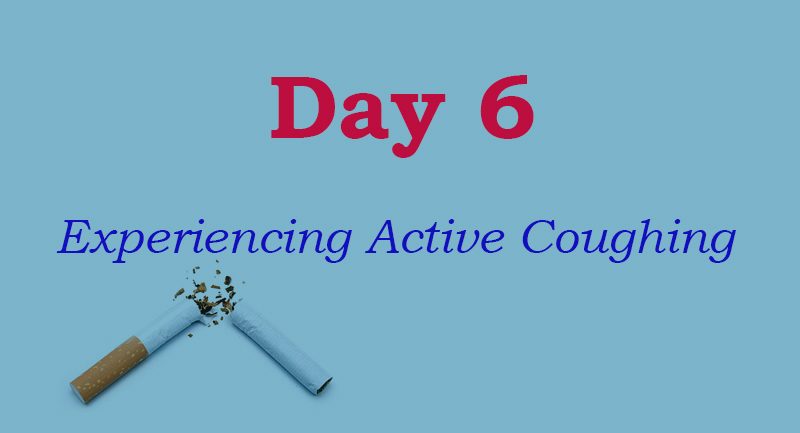
What happens in the body
Increased mucus production in the lower segments of the lungs. Bronchial cilia are actively functioning. Secretory activity of the stomach and pancreas normalizes. Temporary dyskinetic disorders of the gallbladder and duodenum may occur due to nicotine deficiency. On this day, all white blood cells (granulocytes, lymphocytes, neutrophils, macrophages, etc.) grow without the influence of nicotine.
Emotional and Mental State
Withdrawal symptoms return, along with irritability, tearfulness, and sleep disturbances. Aggressiveness increases, and actions are taken in search of cigarettes. It’s challenging to resist the urge, although it is possible to do so.
Physiological Sensations
Vegetative disorders intensify increased sweating, hand tremors, reduced appetite, and nausea after fatty foods. A bitter taste may appear in the mouth, and occasionally there may be pain in the right side under the ribs. Many experience increased thirst, leading to frequent urination. Coughing of dark mucus continues, and it may contain streaks of blood, with a lingering feeling of a lump in the throat.
Day 7

What happens in the body
The taste and smell receptors become more sensitive. Tissue recovery processes in the lungs continue. The tone of the blood vessels in the brain is still unstable.
Emotional and Mental State
Without a doubt, the second week is emotionally easier. Irritability, depression, and aggression are either absent or significantly reduced, making it easier to find distractions from thoughts of smoking. However, psychological dependence symptoms are still present and, in some cases, may even intensify. These include causeless melancholy, feeling lost, sleep disturbances, mood swings, and a sense of loss.
Physiological Sensations
Food has regained its taste and aroma without the nicotine aftertaste, leading to increased appetite (both due to physiological reasons and as a coping mechanism for stress). These days, many people notice weight gain for the first time. Dizziness and decreased blood pressure may bother some individuals.
Day 8

What happens in the body
The taste and smell receptors become more sensitive. Tissue recovery processes in the lungs continue. The tone of the blood vessels in the brain is still unstable.
Emotional and Mental State
Without a doubt, the second week is emotionally easier. Irritability, depression, and aggression are either absent or significantly reduced, making it easier to find distractions from thoughts of smoking. However, psychological dependence symptoms are still present and, in some cases, may even intensify. These include causeless melancholy, feeling lost, sleep disturbances, mood swings, and a sense of loss.
Physiological Sensations
Food has regained its taste and aroma without the nicotine aftertaste, leading to increased appetite (both due to physiological reasons and as a coping mechanism for stress). These days, many people notice weight gain for the first time. Dizziness and decreased blood pressure may bother some individuals.
Day 9
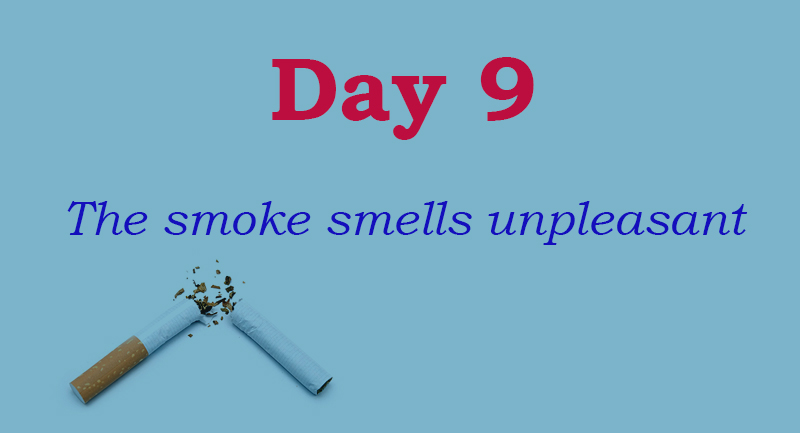
What happens in the body
The condition of the stomach lining normalizes, and the production of essential enzymes and substances, including gastrin, returns to normal. Reparative processes have started in the gastrointestinal mucosa and continue in the bronchopulmonary system. Blood formation improves, and the functions of blood cellular components are restored.
Emotional and Mental State
Difficulties continue due to the absence of the familiar element of a pastime – cigarettes. Those who are forced to be around smokers (at work, in cafes) feel very distressed. During this period, relapses can occur due to external influences.
Physiological Sensations
Many people at the beginning of the second-week notice that the smell of tobacco smoke now triggers disgust. Abdominal pain, heartburn, alternating diarrhea, and constipation may occur. Appetite increases. Temporary deviations in the white blood cell count may be observed in laboratory tests. During these days, many quitters may experience the onset of respiratory infections, allergies, and herpes outbreaks. Dizziness may also occur.
Day 10

What happens in the body
The processes in the lungs that started on the third day of quitting will continue for about six months or longer in smokers with a long history. The lungs and blood vessels continue to adapt, while the immune system has begun its restoration process.
Emotional and Mental State
Quitting smoking no longer triggers distressing thoughts, but being around smokers becomes more challenging. As internal self-motivation reserves near their end, support from loved ones or like-minded individuals is crucial in the next 10-15 days.
Physiological Sensations
The cough persists and is not related to body position in bed. It becomes milder after consuming hot food or drinks and continues to expel mucus. Many people notice the expulsion of small light-yellow or grayish clumps with an unpleasant odor during coughing. These may be tonsil plugs or sloughed bronchial epithelium. It is recommended to seek consultation with an Ear, Nose, and Throat (ENT) specialist and undergo a chest X-ray to rule out any pathological processes in the lungs.
Day 11

What happens in the body
During the second phase of quitting smoking, the tone of small blood vessels (arterioles) that deliver arterial blood directly to tissues normalizes. At this stage, the effects of smoking cessation begin to manifest in the hormonal sphere, influencing metabolism. This explains the changes in mental state and the potential weight gain (or reduction) in some individuals.
Emotional and Mental State
Increased irritability in both genders, while women may experience tearfulness, feelings of insignificance, and emptiness, and men may become more aggressive. The craving for cigarettes intensifies, often masked as a desire to test if the taste and smell of smoke are still appealing.
Physiological Sensations
Dizziness, trembling of the fingers, a sense of inner tension, and occasionally headaches. These sensations should not be mistakenly attributed to withdrawal syndrome; they are related to the brain being oversaturated with oxygen. Appetite increases, particularly noticeable in the evening or under the influence of external stressors.
Day 12

What happens in the body
The normalization of vascular activity leads to improved tissue tropism (nutrition), including the skin. An active process of resolving chronic inflammation in the lungs and gastrointestinal tract (GIT) begins. The second generation of “white blood cells” has grown and become functional, fully protecting the body from bacteria and viruses.
Emotional and Mental State
The emotional and mental state is similar to the previous day, and support from others still plays a significant role.
Physiological Sensations
Those who smoked for a short time and young people under the age of 30 will notice, for the first time, an improved complexion. The cough becomes less severe, and the function of the intestines is almost fully restored.
Day 13

What happens in the body
The skin cells are actively renewing, and the cells that were formed during smoking are still on the surface, but the deeper layers of the skin are no longer affected by nicotine. The vascular tone remains unstable.
Emotional and Mental State
Many people become obsessed with the desire to reach a certain day they consider significant or have set as a milestone. Usually, it’s the end of the second week, and the predominant emotion is the eagerness to achieve the coveted “14 smoke-free days.” The desire to smoke is more related to curiosity.
Physiological Sensations
General discomfort with unclear localization, weakness, a feeling of heaviness in the occiput, and possible fluctuations in blood pressure are all connected to the disruption of neurohumoral regulation due to the nervous system not yet being fully restored.
Day 14
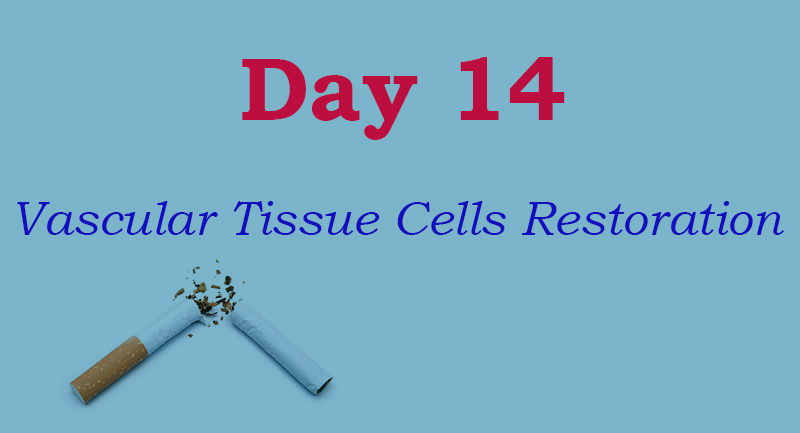
What happens in the body
The healing of the bronchial mucosa, damaged by tobacco smoke, is coming to an end. Platelets have almost been renewed, but red blood cells are still the “old” ones that formed under the influence of nicotine aggression. The vessel walls are receiving sufficient nourishment, and the restoration of their tissues, primarily the endothelium, is commencing.
Emotional and Mental State
These days are psychologically challenging, as well as the following ones, as they are crucial and pivotal. Some individuals cannot resist the temptation and try a cigarette, justifying it by the belief that they have managed to abstain for quite a long time and one cigarette is unlikely to do harm. Unfortunately, this leads them back to the ranks of smokers.
Physiological Sensations
The cough starts to subside, except for those who have been smoking for 20 years or more.
The yellow color on the fingers, where the cigarette was held, begins to fade, and the complexion continues to improve. Vegeto-vascular disturbances may occur, including weakness, drowsiness, and sluggishness.
Day 15-30
 During this phase, your circulation improves significantly. This can result in better skin health and a healthier appearance. Breathing becomes even easier, and physical withdrawal symptoms diminish. Embrace these positive changes as tangible evidence of your body’s remarkable ability to heal itself.
During this phase, your circulation improves significantly. This can result in better skin health and a healthier appearance. Breathing becomes even easier, and physical withdrawal symptoms diminish. Embrace these positive changes as tangible evidence of your body’s remarkable ability to heal itself.
Month 1

By the end of the first month, the foundation for the subsequent cellular recovery of the body is laid. Epithelial cells have been renewed, allowing the normalization of absorption and synthesis processes to create building material for new cells that will function without nicotine and combustion by-products.
The first month is quite challenging from a psychological perspective, and by the end of the month, two scenarios may unfold. Some individuals take pleasure in successfully quitting smoking, which gives them additional strength, while others count the smoke-free days and have to constantly fight the urge to smoke. Both scenarios are normal and hardly affect whether a person will relapse in the long run or not.
Month 2
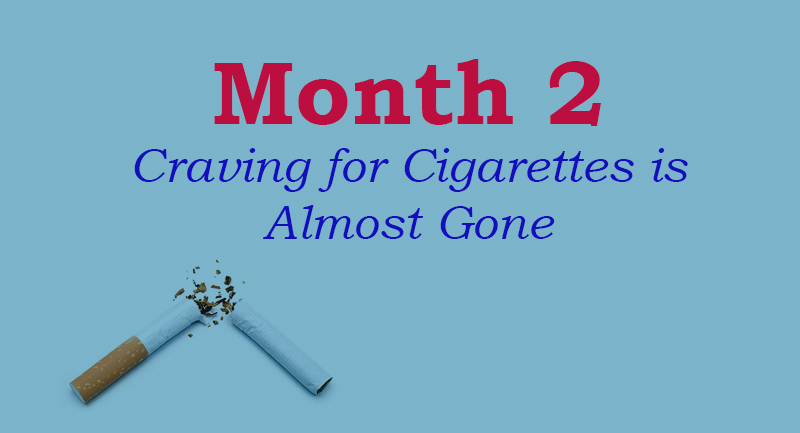
These and the following three months are the most enjoyable for women who have quit smoking. Skin cells have undergone three to four renewal cycles, and the unhealthy yellowish tint has significantly reduced, as well as skin dryness. Some redness (couperose) is still present due to the fact that the vascular cells have not started renewing yet. Only about 50-70% of endothelial cells in blood vessels are new by the second month, and the renewal process continues.
In the lungs, the cellular-level recovery is ongoing, but it has not reached the acini – the tiniest “bricks” that make up lung tissue. Due to this reason, the FEV (Forced Expiratory Volume) of the ex-smoker has not yet returned to the age-specific norm. Coughing and throat dryness may still occur periodically, along with the production of mucus or phlegm. Physical exertion can lead to significant coughing and fatigue.
The craving for cigarettes is practically non-existent, but the desire for the rituals associated with smoking and the familiar environment still lingers. Overcoming these urges has become easier, but willpower and support are still required.
Month 3

From the third month, a full-fledged recovery of the blood vessels begins. Prior to this time, their tone could easily be affected by external factors and stress. By the third month, the tone returns to normal, thanks to the ongoing plastic processes in the endothelium and other linings of small blood vessels.
The critical period, during which many people return to smoking, is coming to an end. The physical craving for nicotine has long gone, and the psychological dependency is diminishing. However, any practical attempt to “try,” “remember,” or “check” can be a step towards returning to smoking.
Dizziness and headaches are almost not bothersome (unless a person has any clinically significant conditions), sleep has normalized, and appetite is either normal or slightly increased.
Month 4

The skin cells have been renewed, and now the complexion has almost returned to normal, and the peeling and itching (which were particularly bothersome in the first two weeks) have disappeared.
The stomach, pancreas, and liver produce a normal amount of hydrochloric acid and enzymes, which allows food to be well absorbed. The intestines are functioning smoothly, and there will be no more stool disruptions related to nicotine withdrawal.
The critical three-month milestone has been overcome. The need to “comfort eat” in response to stress significantly diminishes, and the body weight, which increased for many during the first three months, stabilizes, making diets more effective. With the digestive system functioning properly, sufficient nutrients can be obtained from moderate-sized portions of food.
Month 5
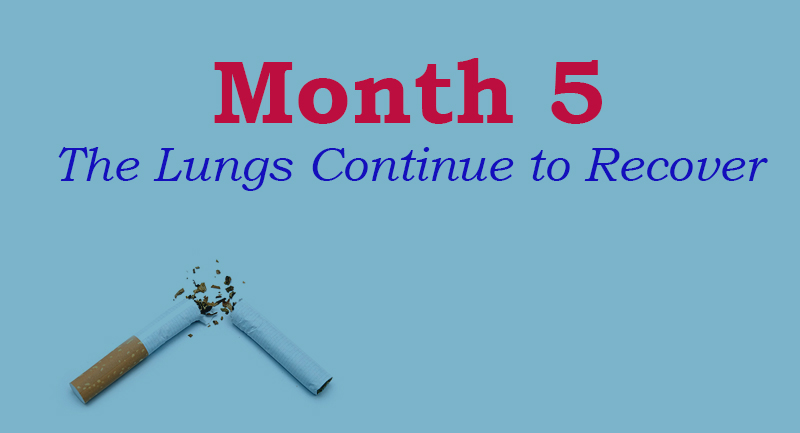
The cells of a smoker’s liver faced the greatest difficulty. Only from the end of the fifth month, do regeneration processes begin in some liver cells, and healthy cells take on some of the functions of the deceased hepatocytes.
The lung tissue continues to recover, and there is either no or very little mucus production, and it no longer has a dark color. From the fifth month, one can gradually start engaging in physical exercises, with swimming and cycling being the most suitable options. Running and strength exercises are better to postpone until 8-9 months.
Occasionally, the desire to smoke a cigarette arises, but it needs to be resisted. The fewer situations that provoke smoking, the easier it will be to hold on until the next critical period at 9-10 months.
Month 6

Six months ago, the last cigarette was smoked. Now, the bloodstream carries cells that have not been exposed to nicotine and its metabolites. They function fully, actively transporting oxygen, and the blood test results are normalizing.
The regeneration of liver cells continues, and over the next 4-6 months, it will accelerate, making the liver function more efficiently.
The acini of the lungs are also engaged in the recovery process. Many people notice that breathing has become easier during this period as if the lungs have expanded.
If spirometry is performed, a noticeable increase in lung capacity can be observed, indicating the active restoration and effective cleansing of the bronchopulmonary system.
Weight has stabilized. The desire to eat instead of smoking occurs less frequently, and if a person finds ways to distract themselves from thinking about smoking, the craving may disappear altogether.
Month 7

Interestingly, many people after seven months without cigarettes suddenly start to distinguish subtle nuances of smells. This is noticeable in their heightened perception of women’s perfumes. If previously they could only categorize them as either light or heavy, now their nose can distinguish between herbal scents and the scent of white flowers. Taste perception also becomes enhanced as, by this point, most taste receptors have fully recovered.
Month 8
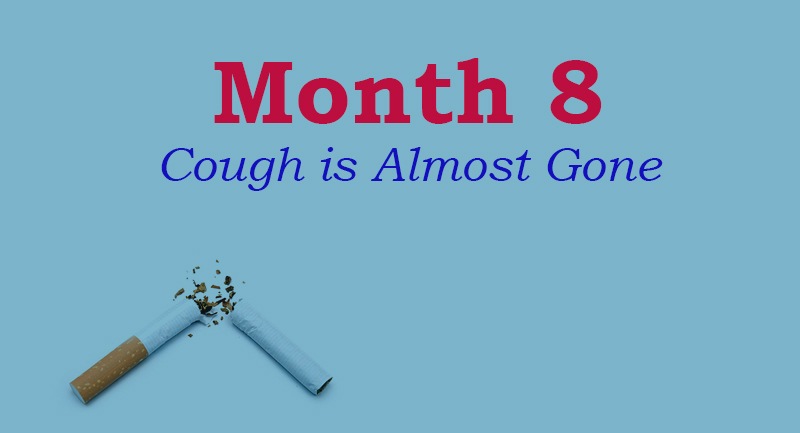
The majority of former smokers do not experience mucus production during coughing. Even the cough itself is hardly bothersome as the lungs have “learned” to cope with arising issues. Those who have reached the stage of Chronic Obstructive Pulmonary Disease (COPD) also feel relief as the condition enters a phase of stable remission, which can last indefinitely if all the doctor’s recommendations are followed.
Month 9
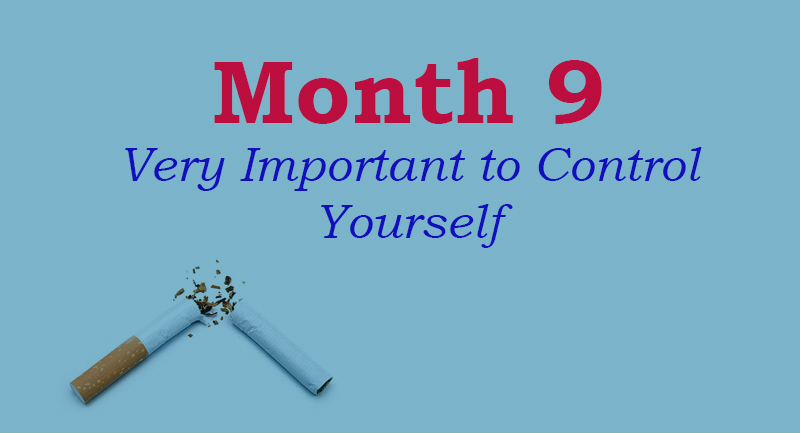
It is considered the beginning of another critical period: the difficulties of the first days and weeks of quitting are already forgotten, the smell of cigarettes does not trigger any personal associations, but the habit’s automatism still remains. Now, it is important to regain self-control and avoid situations where a cigarette is lit “automatically,” mechanically. This could happen in places like the smoking area at work, the balcony, or the entrance of the building.
Month 10
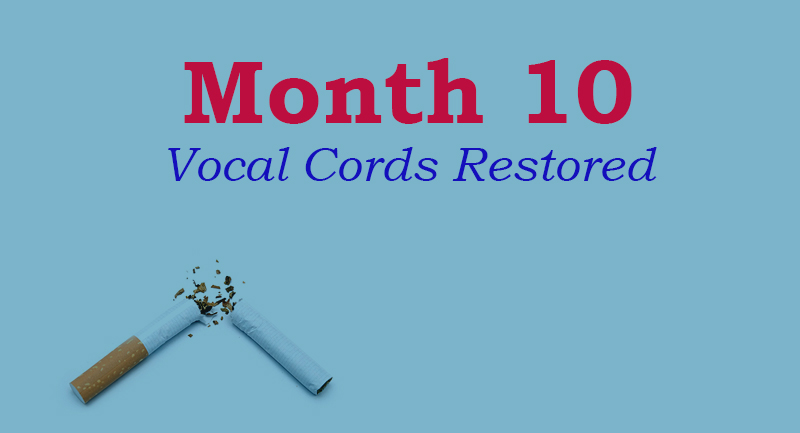
Many have noticed that after 10 months without cigarettes, they start having dreams in which they smoke. During the day, they can easily do without cigarettes (as long as they don’t provoke themselves), but smoking in the dream feels very real, and waking up can be quite distressing. Some individuals may automatically light up a cigarette in the morning after such dreams, but fortunately, not everyone returns to the ranks of smokers.
An interesting observation during this month: people who love to sing notice that singing becomes easier, and they have better control over their vocal cords.
Month 11

Running, brisk walking, gym workouts, and other sports activities are now allowed as the lungs can handle the load. Of course, it’s essential to start gradually to avoid disrupting the results of the quite lengthy recovery period.
After almost a year, do people still feel the desire to smoke? Most admit that, yes, they do. However, it’s not a craving for nicotine; rather, it’s a feeling of missing certain elements of social interaction, work, and daily activities. The difficulties experienced when quitting and the sensations the body had as a smoker are long-forgotten.
The risk of relapse is small—around 25%—but nonetheless, it is real.
Month 12

The milestone period. The hard work done over the past year deserves praise: overcoming what became a habit is a significant achievement!
Now, the risk of a heart attack has been reduced by 50% compared to the same day a year ago. The risk of a stroke has decreased by 30%. The risk of developing cancer has also been lowered: by eliminating other risk factors, the likelihood of lung and liver cancer has decreased by almost 80-90%, esophageal and stomach cancer by 60-70%, and lip cancer by nearly 100%.
Is a relapse possible? Absolutely. The risk of returning to smoking lies not in nicotine; as they say in addiction recovery, it’s all in the mind. Working with harmful desires and habits is necessary at all times- this is the key to success, longevity, and good health.
Organ Cleaning
So what happens to your body when you quit smoking and what are the benefits for your organs?
Lungs
From the moment you quit smoking, your lungs begin the healing process. Cilia, the tiny hair-like structures lining your airways, regain normal function, enabling them to remove mucus and toxins more effectively. Over time, lung tissue heals, reducing the risk of respiratory infections.
Heart
Within a few days of quitting, your heart rate and blood pressure stabilize, alleviating strain on the cardiovascular system. As the months pass, the risk of heart disease steadily decreases, improving your overall cardiovascular health.
Skin
What happens to your skin when you quit smoking? Improved blood flow and oxygenation contribute to the restoration of a healthier complexion. Reduced exposure to the harmful chemicals in cigarettes helps slow down premature aging, allowing your skin to regain its natural radiance.
Emotions and Thoughts
Quitting smoking often triggers a range of emotions and thoughts. It’s important to be prepared for these experiences and develop healthy coping strategies:
Positive Emotions: Many individuals who quit smoking experience a sense of pride, accomplishment, and increased self-esteem. Taking control of your life and being free from the grip of addiction fosters a newfound confidence and inner strength.
Challenges: Withdrawal symptoms, such as irritability, anxiety, and cravings, may arise in the early days. It is crucial to find healthy outlets for stress and emotions, such as engaging in regular exercise and practicing relaxation techniques. It’s important to seek support from friends and family to overcome nicotine withdrawal symptoms.
Suggestions for Relatives
Relatives play a huge role in supporting a loved one’s journey to quit smoking. Here are a few suggestions to help:
Be Understanding: Understand that quitting smoking can be challenging. Offer patience, empathy, and support, especially during moments of heightened stress or withdrawal symptoms.
Create a Smoke-Free Environment: Assist your loved one in creating a smoke-free environment at home. Remove ashtrays, eliminate triggers, and encourage healthy activities as alternatives to smoking.
Offer Encouragement: Acknowledge their progress and achievements along the way. Celebrate milestones, share positive experiences, and provide encouragement during difficult times.
Doctor’s Recommendations
Seeking guidance from healthcare professionals can greatly enhance your quit-smoking journey. Here are some recommendations to follow:
Consult Your Healthcare Provider: Schedule an appointment with your doctor to discuss your decision to quit smoking. They can provide personalized guidance, support, and resources tailored to your needs.
Consider Medications or Nicotine Replacement Therapy: Your healthcare provider may recommend medications or nicotine replacement therapy to help manage withdrawal symptoms and cravings. Follow their advice and adhere to prescribed dosages.
Regular Health Check-ups: Attend regular check-ups to monitor your overall health and progress. Your doctor can assess improvements, address any concerns, and provide ongoing support throughout your journey.
Nicotine Withdrawal and Cravings
Nicotine withdrawal symptoms are a common experience when quitting smoking. Their duration and intensity can vary from person to person. Here’s a general nicotine withdrawal timeline:
First 24-48 hours: Nicotine cravings typically peak during the first two days after quitting. You may experience irritability, anxiety, difficulty concentrating, and intense cravings.
2-3 days: The physical symptoms of nicotine withdrawal start to subside. Cravings may still be present but become more manageable.
1 week: Most physical withdrawal symptoms, such as headaches and nausea, begin to fade away. However, cravings may still persist, though they are usually less intense.
2-4 weeks: Nicotine cravings become less frequent and less intense. The majority of withdrawal symptoms resolve during this time, but occasional cravings may still arise.
3 months to 1 year: Cravings gradually decrease in frequency and intensity over time. By the end of the first year, many individuals experience significantly reduced cravings or may not experience them at all.
It’s important to remember that everyone’s quit-smoking journey is unique, and some individuals may experience cravings for a longer or shorter period. Developing coping strategies, seeking support, and staying committed to your decision to quit can help manage nicotine withdrawal symptoms.
Tips for Quitting Smoking
Quitting smoking can be challenging, but with the right strategies and support, it is possible to succeed. Here are some tips to help you on your journey:
Set a quit date: Choose a specific date to quit smoking, giving yourself time to prepare mentally and emotionally.
Find support: Inform your family, friends, and coworkers about your decision to quit. Seek support from loved ones who can provide encouragement and accountability.
Consider counseling or support groups: Individual counseling, group therapy, or support groups can provide valuable guidance and support during your quitting process.
Remove smoking triggers: Rid your environment of cigarettes, lighters, and ashtrays. Avoid situations or activities that may tempt you to smoke.
Develop coping strategies: Find healthy ways to cope with cravings and manage stress. Exercise, deep breathing, meditation, or engaging in hobbies can help distract from cravings and reduce withdrawal symptoms.
Reward yourself: Celebrate milestones and achievements along the way. Treat yourself to something you enjoy, like a movie or a small gift, as a way to acknowledge your progress.
Cigarette Replacement Ideas
When quitting smoking, some individuals find it helpful to replace the physical habit of smoking with healthier alternatives. Here are some ideas:
Nicotine replacement therapy (NRT): NRT products, such as nicotine gum, patches, lozenges, or inhalers, can help manage cravings and gradually reduce nicotine dependence. Consult your healthcare provider for guidance on choosing the right NRT option for you.
Oral substitutes: Chewing on sugar-free gum, sucking on hard candies, or munching on carrot sticks or celery can provide oral stimulation similar to smoking.
Find distractions: Engage in activities that keep your hands and mind occupied, such as puzzles, knitting, or playing a musical instrument.
Stay active: Physical exercise not only helps distract from cravings but also promotes overall well-being and reduces stress.
Remember, finding the right cigarette replacement method or combination of methods is a personal process. Experiment with different strategies and consult healthcare professionals for guidance and support.
Conclusion
By following this comprehensive timeline and utilizing the tips and suggestions provided, you can embark on a successful quit-smoking journey and Tobacco Free Allegheny (TFA) wishes you much success in it. Experience and enjoy the remarkable health benefits and improvements that come with a smoke-free life!

















 During this phase, your circulation improves significantly. This can result in better skin health and a healthier appearance. Breathing becomes even easier, and physical withdrawal symptoms diminish. Embrace these positive changes as tangible evidence of your body’s remarkable ability to heal itself.
During this phase, your circulation improves significantly. This can result in better skin health and a healthier appearance. Breathing becomes even easier, and physical withdrawal symptoms diminish. Embrace these positive changes as tangible evidence of your body’s remarkable ability to heal itself.











